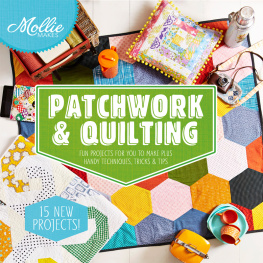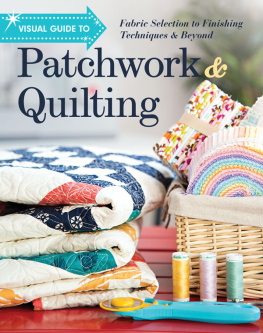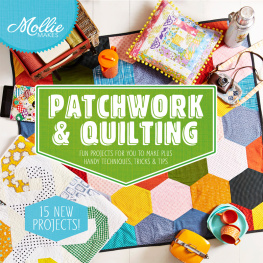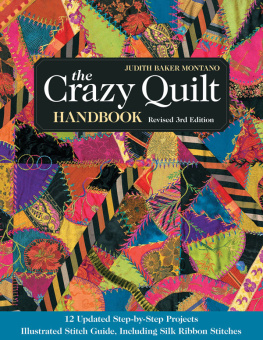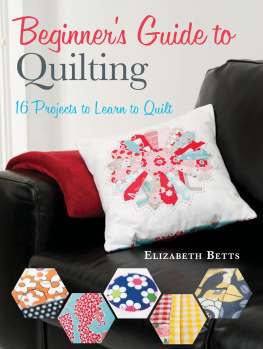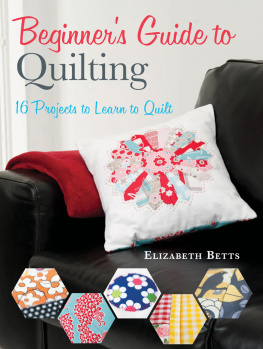

Get piecing!
When I think patchwork, I think of my auntie. Her craft room is a thing to behold all colour-coordinating baskets of rainbow fabrics, buttons, beads and threads. She makes such beautiful quilted bags and cushions, and whenever I visit she still lets me choose one to keep.
The texture, intricacy and work that goes in to this work are all so appealing to the senses. Choosing your fabrics is a complete joy, and the pride you feel when your work is complete? So, so good!
Whatever your level of skill with this time-honoured craft, we have it covered here. With techniques and plenty of beautiful modern projects to try its all you need to get cracking and start your own stitching journey.

Lara Watson
Editor, Mollie Makes
note
Measurements are given in metric and imperial: choose one or the other and stick to it for each project or technique do not be tempted to mix and match.

| This unlined curtain panel is a perfect way to hide the clutter on open shelving and it is hung by threading a curtain wire through the channel at the top. It is a great project for using up your favourite fabric scraps and the brick pattern piecing will look just as good in solids as it does in prints. |
MATERIALS
One piece of gingham cotton fabric 82 x 22cm (32 x 8in) for top panel
21 pieces of cotton fabric each 22 x 14cm (8 x 5in) for the full bricks
Six pieces of cotton fabric each 12 x 14cm (4 x 5in) for the half bricks
Sticky notes
White sewing thread
Pinking shears (optional)
Curtain wire for hanging
SIZE
88 x 77cm (34 x 30in)
FEATURED TECHNIQUES
For more on brick piecing and variations
BEFORE YOU BEGIN
The curtain was made with a finished size to hang from a kitchen worktop to hide a standard-size appliance, and you may need to adjust the size to fit your appliance. To make a pair of curtains to hang in a window, line the back with a plain fabric.
Prewash and press fabrics before use as necessary: this is particularly important if you are using vintage fabrics as these may have dyes that run when washed.
To cut out your fabrics, you can make a full brick template measuring 22 x 14cm (8 x 5in) and a half brick template measuring 12 x 14cm (4 x 5in) from template plastic. (These template sizes include seam allowances.)
When piecing the patchwork, pin and stitch together with right sides facing. All seams are 1cm (in) unless otherwise stated.

| Patchwork Story One day when I was folding up some fabrics to store away, I noticed how sweet they looked together and thought Id like to make them into a patchwork. It had to be a quick project that wouldnt use much fabric, so I made this little curtain to hang in the kitchen. It covers up our washing machine and is so bright and cheerful that it makes doing the laundry a much happier job. Jane Hughes |

METHOD
{01} Lay out your fabric pieces
Following the patchwork piecing diagram, lay out your fabric pieces, arranging them so that no two pieces of the same fabric are next to each other: start with a row of solid brick pieces; the second row will be offset, so start and end this row with a half brick piece. Continue the rows to complete the brick pattern layout. It is a good idea to take a quick photograph of your fabric layout at this stage for future reference if needed. Place a sticky note on the first (left-hand) piece of each horizontal row and number 1 to 6. Gather up the first row in order so that the numbered fabric piece is on top, and pin together. Gather up each row in turn to give you six piles of fabric.
{02} Piece the brick pattern panel
Begin sewing the first row of fabric pieces together, then continue to sew the pieces in each row in turn to give you six horizontal rows, pressing all seams to one side as you go. Sew each row together in order (use your number stickers to remind you, then remove).
{03} Add the top panel to the patchwork panel
Align the top panel to the top edge of the patchwork panel with right sides facing and stitch together; press the seam open.
{04} Finish the curtain
To hem the sides and bottom of the curtain, fold over the edges twice, then press and stitch 5mm (in) from the edge. To hem the top and make a channel for the curtain wire, fold over 3cm (1in), then fold over another 3cm (1in); pin, then stitch, leaving each end open. (The channel depth can be adjusted to fit the overall length required, but do check that you can thread the curtain wire through it.)
As the reverse of this curtain will not be visible, it is unlined, but, to prevent fraying, it is a good idea to finish the seams with pinking shears. Press the panel, thread the curtain wire through the channel, and hang.

PATCHWORK PIECING DIAGRAM
note
To line the curtain panel, work to the end of step 3, then measure the panel and cut out a piece of lining fabric to the same size. Pin lining and curtain right sides together; sew along the sides and bottom, leaving the top edge open. Turn right side out and press. Hem the top edge as described in step 4, leaving the ends open to thread the curtain wire through.
JANE HUGHES

Jane from littleteawagon is a crafter/designer with a fondness for fabrics and sewing, doodling and making and blogging about a crafty life. www.teawagontales.blogspot.com

| This super-comfy beanbag is pieced using simple squares with a nine-patch top. Its a great way to explore combining vintage fabrics with contemporary prints. A few scuttling beetles have been appliqud over the finished patches, which are a great way for beginners to hide less than perfect pieced seams! |
MATERIALS

